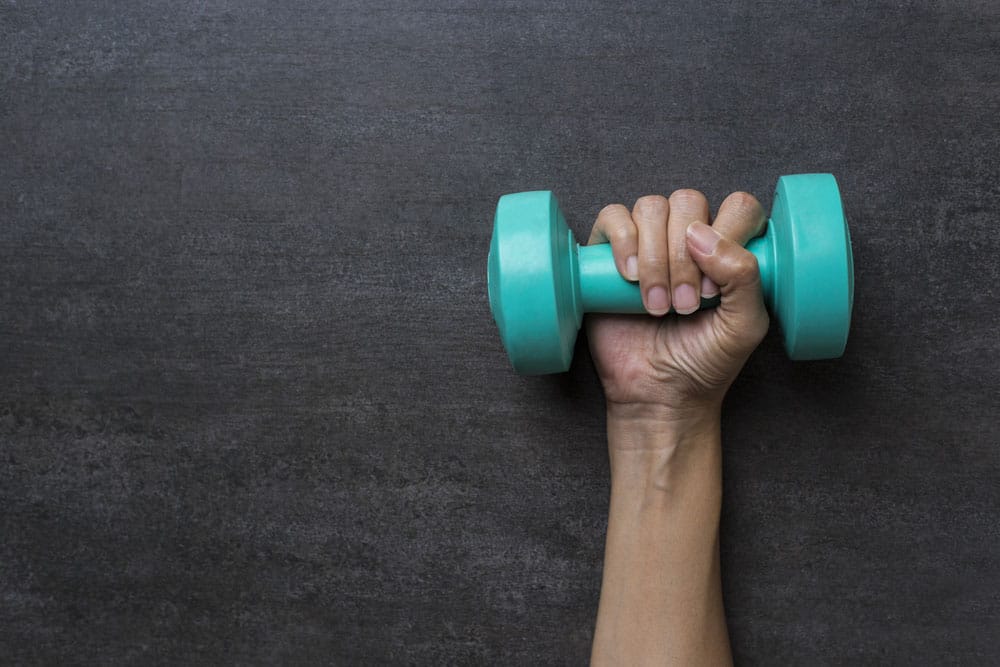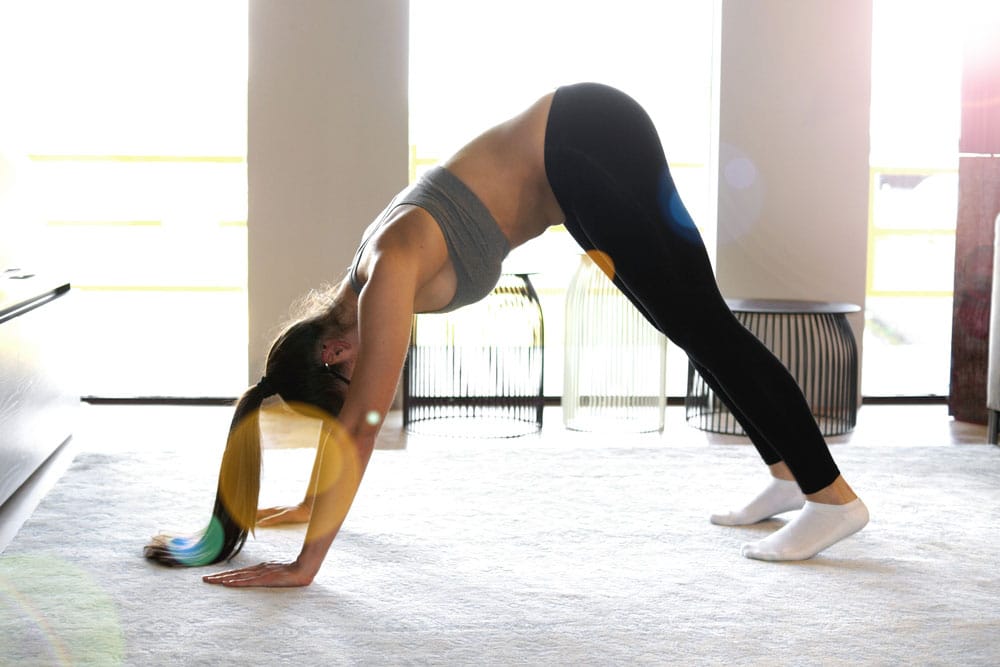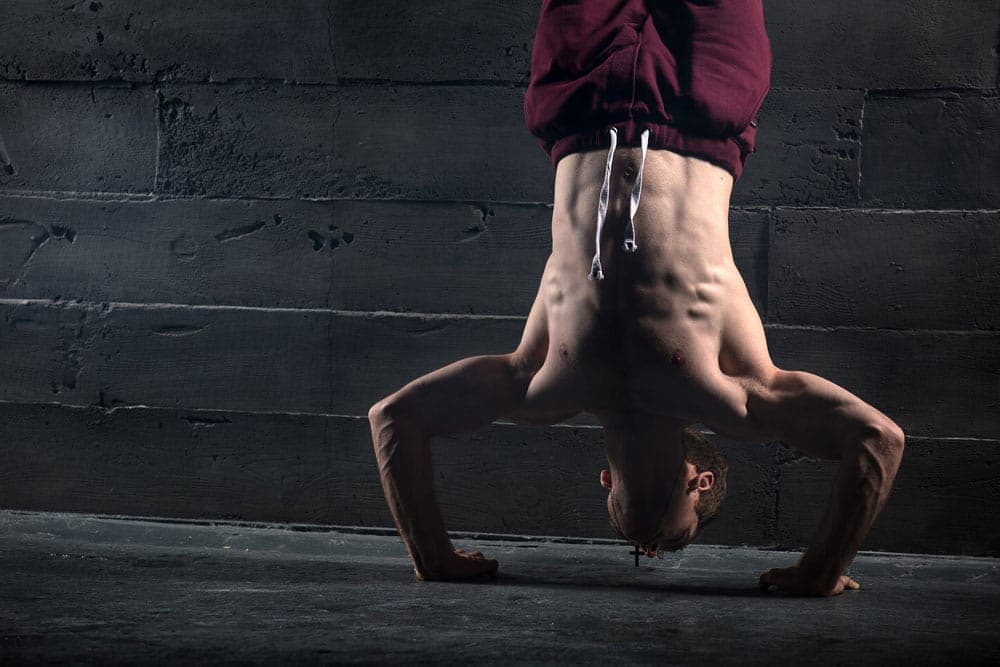Handstand Benefits: Why Daily Handstands Could Be Good for You
Learn about handstand health benefits. Find out how daily handstands can improve your balance, core strength and confidence.
As long as humans have been around, we've been accustomed to walking on our feet. Can you imagine what would happen if things were flipped the other way around? The handstand benefits you'd get from seeing the world upside down are endless!
Let's take a look at what a regular handstand practice can do for your body. Learn how handstands might regulate your hormones. Plus we'll take a look at some progressions you can use to get up into a full handstand.
Handstand Benefits
Although you may not see people doing handstands in your gym, these are challenging body-weight moves that take a little bit of time to perfect.
Handstands are a staple in fields like yoga, gymnastics, and calisthenics. They’re known as inversions. This applies to any exercise where your head moves underneath your heart.
Inversion therapy research is an emerging field of study, and while we have some evidence that inversions could reduce back pain, this only applies to inversions performed on an inversion table, not those with an arm balance, like a handstand. More research is needed in this domain.
That being said, let's see a few benefits that handstands can have on your body and mind.
Stress Reliever
Handstands are going to help increase the flow of blood to your brain.
Because you're standing upside down, more blood can rush to your brain in a handstand.
Some research suggests that this could help balance out your cortisol.
In yoga, there's a school of thought that supports the idea that inversion poses or bringing your head below your heart helps to support your stress response. Movements like handstands can promote a feeling of calm by helping to reduce your cortisol.
Putting your hands on the ground and balancing upside down may also help blood flow to the brain. This can make you feel happier and more relaxed. Brain function and inversions is still an emerging field of study.
Balance
Most of us balance on our feet without thinking. We do it when we walk every day. But it takes a little bit more conscious effort to be able to balance on your hands.
This balance challenge requires a lot of engagement from not only your arms but your stabilizer muscles including the core and legs.
To stay up in a handstand, you need to have proper alignment making sure your head shoulders and arms are all in line to keep you up. Handstands are a very challenging move to help improve your balance.
Core Strength
Since you need to hold your body stable in the air while you balance, your core is hard at work when you do a handstand.
Wrist Strength
Handstands can be very taxing on your wrists. If you think about it, you're supporting your full body weight on just your hands.
Training in handstands can help you improve your wrist strength. This comes in handy for other moves like push-ups, or even your grip for things that require you to hang from a bar. Make sure to always stretch out your wrists after you perform a handstand to avoid injuries.
Confidence
Being able to perform a handstand can make you more confident. It's a skill that most of the population can't do so you set yourself apart.
Although you should focus more on functional strength training too, mastering a tough trick like a handstand can help improve your confidence.
When you first kick up into your handstand (we'll get to this a little bit later), there's a sensation between having your feet planted on the ground to getting them up in the air where you get a sense of letting go.
This break in your movement forces you to trust yourself as you shift your weight from your feet to your hands.
Trusting yourself enough to let go both mentally and physically can foster a sense of connectedness with yourself and improve your confidence.
Handstand Risks
Although the handstand is an impressive move to master, it does require a little bit of work to get into the full variation of this pose.
We don't recommend full handstands to gym newbies since they do come with a lot of risk, especially if you're not working with a spotter.
That being said you can certainly work on handstand progressions, or build up the strength in the rest of your body until you can do a handstand. We'll come to techniques to work on this a little bit later.
First, let's look at a couple of things that can go wrong in a handstand. Knowing the risks will allow you to avoid injuries, and work through smart progressions that allow you to perform healthier handstands.
Wrist or Hand Injuries
As you can imagine, the handstand places your entire body weight on your hands and wrists. If you don't have good alignment or if you have very weak wrists, it's easy to injure your wrists in this position.
Make sure to work on wrist-strengthening moves before you train your handstand. For a warm-up, you can always do wrist rolls, wrist stretches from an all-fours position or even wrist curls with light weights. It's a good idea to train push-ups or high planks as well if you're working on a handstand.

A push-up only puts about 60 to 70% of your body weight into your hands, compared to a handstand which uses 100%. So this can be a safer way to train if you're building strength for a handstand. Not only this, but handstands also help engage your core muscles. You'll need a strong core for your handstand practice.
All of these moves will help you keep your wrists injury-free in your handstands.
Head Injuries or Falls
As you can imagine, it is possible to fall from a handstand and injure yourself. Although for people that have the required strength to do this move with proper technique, it can be safe, it is riskier than other gymnastic or yoga moves since your body is all the way upside down.
This leaves you sensitive to falls. And if you do fall, it is riskier than in other positions since you would be falling directly on your head. Once you learn how to kick up to a handstand with proper technique, always aim to fall in the direction that you kicked up if you have to bail.
This helps protect your head and neck from injuries that could be severe or cause damage to your spinal column.
Severe head trauma like skull fractures or brain injuries are unlikely when you practice handstands even if you fall. For most of us, reflexes kick in so we fall in a way that at most results in a bruised ego.
That being said, it's helpful to have a spotter on hand if you're scared of falling.
How to Get Into a Handstand
Handstand Progression— Pike Hold
A pike hold will get you familiar with the sensation of being upside down and putting weight into your hands.

To perform a pike hold, grab a weight bench or block if you're in the gym. At home, you can even use a chair or the side of your bed.
Lay on your front in a prone position, and crawl your hands out to the floor in front of you. planting your feet on whatever surface you're working on. Keep crawling forward until you can straighten your legs and your arms.
Bring your pelvis in line over your shoulders, maintaining a neutral spine. Plant your hands firmly on the ground at shoulder width apart. Spread your fingers wide to create a solid base. Keep your biceps in line with your ears so you frame your head.
If you have bad bicep genetics, you may want to focus on some extra bicep curls in your spare time. That way, you keep your arms glued to the sides of your head.
Pro tip: While your body is in a pike position, why not try some pike push-ups? These will help you get familiar with bending into your arms and what locked-out elbows should feel like. Getting comfortable locking out your elbows will help you once you come to a full handstand.
Walk-Up Wall Hold
Once you're comfortable with an inversion in the pike position, you can start bringing your legs over your head.
To do this with support for your balance, find a wall. Bend down to plant your hands in front of you with your palms pushing into the ground and your fingers spread wide. Think of clawing through the tips of your fingers.
Crouch down. Push into your hands and slowly start to walk your feet up the wall. As your legs get higher and higher and eventually straighten out, walk your hands in so your body gets more parallel to the wall.
Once you're up, hold this position for 30 seconds, then walk your feet back down the wall, walking your hands away from you and come back down to crouch.
Repeat this move for 3 or 4 reps.
Kick Up Wall Hold
Now we'll start adding some momentum to get up into a handstand. Facing your body to the wall, plant your hands with your fingers spread slightly away from the wall.
Look directly between your hands, and in one swift movement kick your legs up and overhead to a straight position. They should hit the wall once you're up, but if you have the strength to hold your body up, most of your balance will be in your hands.
Hold this position for 30 seconds, then slowly kick your legs back over your head to return to the ground. Repeat this move for 3 to 4 reps.
Full Handstand Kick Up
Finally, to get into a full handstand unassisted, you'll need to use your core strength and your balance to kick up.
With no wall to support you, perform the same movement that you did in the wall handstand kick-up. You're using the same motion, only you don't have support once you're up in your handstand. You'll need to hold this move by yourself using your core stability.
Pro tip: swing your upper body back slightly for better momentum before you drive your hands down and into the ground and bend your knees before kicking your leg up to your handstand. If you have the core strength, you should have no trouble balancing at the top of your handstand.
Squeezing your glutes, engaging your hip flexors, and keeping your legs straight at the top of your handstand will also help you balance. Once you master a straight legged handstand, you can play around with moving your legs in the air.
If you want to really test your upper body strength, some pros can even do one-handed handstands!
Using momentum will just help you get there. Once you’ve perfected this progression, you can start coming into a handstand from the pike position using your core instead of momentum.
Handstand Tips
A solid handstand needs a solid base. Focus on spreading your fingers wide and driving your palms into the ground to create a firm base for your handstand.
The wider your hands are, the more support the rest of your body has in this position. Rotate your biceps forward so your elbow creases face to the front as much as possible and remember to fully lock out your elbows.
Locking out your elbows lets your joints stack on top of each other. This is crucial to a proper handstand. With good alignment, a handstand shouldn't cause you pain and should be quite stable.
If your elbows are bending or wobbling at all, you put yourself at higher risk of falling on your head. Once you get up, keep your abs and your glutes turned on, and press your legs firmly together pointing your toes.
This will help keep your whole body in a straight position and promote proper alignment to keep all the parts of your body stacked.
Don't look in front of you. Although this can be tempting, looking down will allow your head to stay in line with the rest of your body, rather than sticking out.
The Takeaway
Handstands are a great way to work on your strength, and confidence. They also help you train a unique skill that might set you apart from others in the gym. This move is practiced commonly in gymnastics, calisthenics or yoga.
Regardless, anyone can learn how to do a handstand with a little bit of technique. Handstands have numerous benefits for your body and mind. They help send blood to your head which may reduce your cortisol leading you to feel less stress.
Since a handstand is very challenging to master, it can also increase your confidence. This move forces you to let go while your body flips all the way upside down and your legs float into the air.
Between your kickoff from the ground and your arm balance, there's a moment of suspension where you need to trust yourself. That's what makes handstands so powerful. They may even boost your confidence in other areas of life outside the gym.
That being said, a handstand does come with a lot of risk if you're new or using poor technique. Wrist or hand injuries as well as head injuries are all potential issues that you might face when doing a handstand.
Make sure you always warm up before you do this move and do not try a handstand unsupported if you haven't made it through all of the progressions. We recommend working with a spotter when you're first training to do a handstand.
Flex offers an all-in-one workout platform to help with workouts that use machines, bodyweight and free weights.
You can learn new exercises, visualize your fitness journey and keep all your PRs in one place, with tracking integrations to hit your daily caloric intake for growth, maintenance or weight loss.
Get simple customized fitness plans or introduce a little friendly competition to your fitness community by sharing exercises with your friends. Try it for free through the Flex fitness app.
References:
Thau L, Gandhi J, Sharma S. Physiology, Cortisol. [Updated 2023 Aug 28]. In: StatPearls [Internet]. Treasure Island (FL): StatPearls Publishing; 2023 Jan-. Available from: https://www.ncbi.nlm.nih.gov/books/NBK538239/
Mendelow, A. D., Gregson, B. A., Mitchell, P., Schofield, I., Prasad, M., Wynne-Jones, G., Kamat, A., Patterson, M., Rowell, L., & Hargreaves, G. (2021). Lumbar disc disease: the effect of inversion on clinical symptoms and a comparison of the rate of surgery after inversion therapy with the rate of surgery in neurosurgery controls. Journal of Physical Therapy Science, 33(11), 801–808. https://doi.org/10.1589/jpts.33.801
Related articles


Get fit with Flex
Build muscle & lose weight fast for free.
Available on iPhone + Apple Watch





